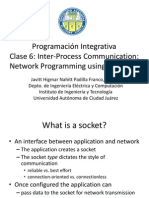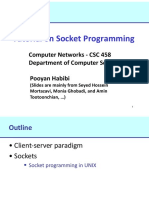0% found this document useful (0 votes)
44 views26 pagesSocket
The document provides an overview of socket programming, detailing how to create network applications that share data and send messages using a client-server model. It explains the layers of networking, the setup and use of sockets, and the importance of DNS for hostname resolution. Key functions and steps for both client and server operations are outlined, including socket creation, binding, listening, accepting connections, and data transmission.
Uploaded by
abdulkerimaragaw936Copyright
© © All Rights Reserved
We take content rights seriously. If you suspect this is your content, claim it here.
Available Formats
Download as PDF, TXT or read online on Scribd
0% found this document useful (0 votes)
44 views26 pagesSocket
The document provides an overview of socket programming, detailing how to create network applications that share data and send messages using a client-server model. It explains the layers of networking, the setup and use of sockets, and the importance of DNS for hostname resolution. Key functions and steps for both client and server operations are outlined, including socket creation, binding, listening, accepting connections, and data transmission.
Uploaded by
abdulkerimaragaw936Copyright
© © All Rights Reserved
We take content rights seriously. If you suspect this is your content, claim it here.
Available Formats
Download as PDF, TXT or read online on Scribd
/ 26



























































































